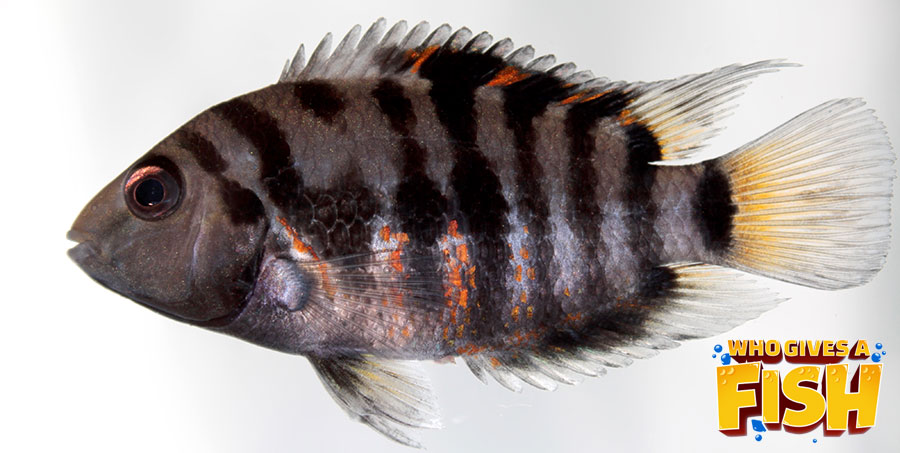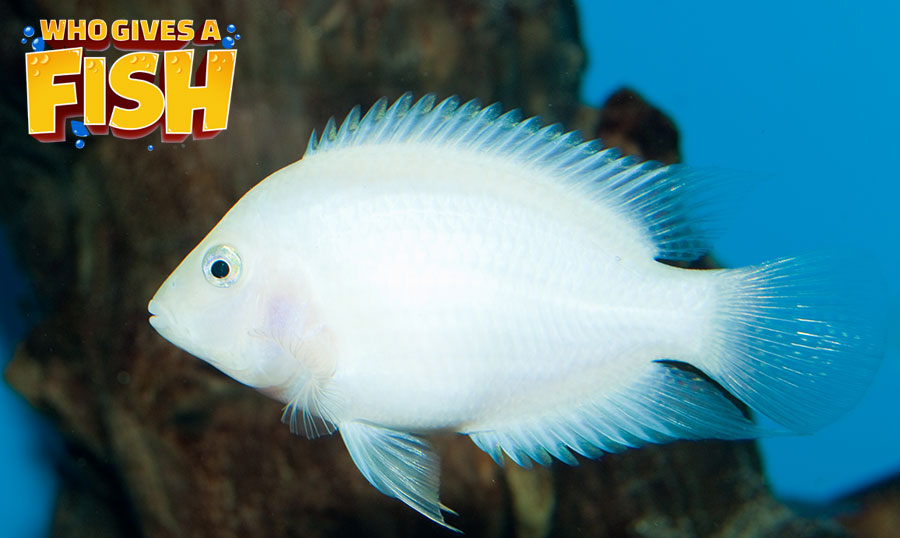Convict Cichlid
The Convict Cichlid, Amatitlania nigrofasciata, is a great Cichlid for any experience level aquarist, and is a hardy fish but with a rambunctious temperament. The Convict Cichlid owes its name to its coloration, in that it looks as though it is wearing an old style prison uniform.
- Experience Level: Beginner
- Hardiness: Very Hardy
- Minimum Tank Size: 30 gal (113 L)
- Maximum Size: 6 in (15 cm)
- Temperament: Very agressive
- Temperature: 74 – 82° F (23.3 – 27.8° C)
- pH Range: 6 – 8
- Water Hardness: 6 – 8 dGH
- Diet: Omnivore
Table of Contents
Introduction
Aquarium Setup
Difficulty
Feeding
Breeding and Social
Also known as the Cichlosoma nigrofasciatum and Archocentrus nigrofasciatus, this Cichlid will reach a maximum size of approximately 6 inches (15 cm). The females display brighter colors while the males are generally bigger fish.
Many different varieties have been bred in captivity, and these include the Albino Convict Cichlid as shown in the image below.
These Cichlids are best kept with other aggressive fish, that are big enough not to be eaten. The Convict Cichlid has a very aggressive attitude towards other fish, regardless of their size. They are known to attack without reason and without provocation (encroachment of territory etc.).
They are also incredibly hardy and require little maintenance apart from your proper aquarium maintenance. They like a rocky landscape with plenty of hiding places. This Cichlid will breed with ease and it is common for them to breed in captivity without any encouragement. Many new hobbyists are graced with the spectacle they put on and cursed with the efforts required to try and save all of the fry!
Again, given it’s aggressiveness, care must be taken when choosing this species and indeed, it’s tank mates. You have been warned!
Aquarium Setup
The Convict Cichlid requires ample space to let off all of its energy. While you could get away with having a pair in a 30 Gal tank, it’s worth noting that any additions will require a larger tank.
Water movement should be moderate to strong in areas and calmer in other areas to feed and rest. They prefer many different structures such as rockwork, wood/branches, and ceramic/clay pots. You will notice that if you have floating plants, that they will often hide under these. They do not appreciate bright lighting.
For any bottom dwelling plants, you are going to have your work cut out for you. The Convict Cichlid will regularly rearrange your plants and unless these are securely anchored into your substrate, they will likely be ripped out and moved elsewhere (often found on the filter intakes!)
Convict Cichlid Aquarium Guide
- Minimum Tank Size: 30 gal (113 L)
- pH Range: 6 – 8
- Water Hardness: 6 – 8 dGH
- Temperature: 74 – 82° F (23.3 – 27.8° C)
- Lighting: Moderate
- Substrate: Prefers sandy bottom with plenty of structure.
- Brackish: Slightly (approx. 1.0001 and under)
- Water Flow: Varied
- Tank Region: Primarily Bottom to Mid
Difficulty
This is an extremely easy fish to keep given its hardness and survival rate. The main difficulties you will face are the aggression this fish demonstrates and the ability to keep your aquascaping and plants where you originally placed them.
Feeding
The Convict Cichlid is not a fussy eater and will take almost anything you offer it. Occasional feedings of protein based foods such as animal heart, liver and worms are recommended, and flake and pellet food that has been enriched with spirulina to assist in excellent coloration.
Feed several times a day, in small quantities. This can help subdue this Cichlids otherwise relentless aggression.
Convict Cichlid Feeding Guide
- Diet: Omnivore
- Frequency: Several small feedings per day.
- Pellet Foods: Yes (Cichlid specific blend, enriched with spirulina is best)
- Flake Foods: Yes (Cichlid specific blend, enriched with spirulina is best)
- Live Foods: Smaller fish, worms and snails will make an easy meal.
- Meat Foods: Animal heart and liver is good to feed occasionally.
- Vegetable Foods: Yes, most finely cut, leafy green vegetables will be taken.
Breeding
The Convict Cichlid is one of the easiest Cichlids to breed in captivity. They will spawn in caves, or pots that you place into the tank.
After initial courting and dancing with each other, usually in the form of head nods, the breeding pair will then clean down an area with ample cover and begin to guard this spot. The female lays on average 30 eggs which are then fertilized by the male. These eggs are almost always found on the roof of the structure (cave, pot etc.).
Depending on the size and age of your female, she will lay up to 250 eggs (possibly more depending on size and health). The site will then be fiercely guarded by the male while she remains with the eggs, slowly fanning them with her fins.
Your tank parameters will determine the speed in which the young hatch, but it is generally within 72 hours, and within approximately 5 days the young will be free swimming. In order to keep these fish, it is advised to remove them to a fry tank with the same water from your main tank. They make for easy food otherwise and the survival rate in a community tank is extremely low for free swimming fry (they are basically free food for other tankmates).
Once in your fry raising tank, you can feed them crushed flake and pellet food (ensure it is fine enough to fit into their mouths). Some protein based foods such as daphnia and brine shrimp are also excellent additions to feed on occasion, just ensure the pieces are small enough for them to consume.
You can also keep the female in the fry tank while raising them, as she will often be seen stirring up ditritus on the bottom of the tank in order to bring small pieces of food into the open for the fry to eat.
The Convict Cichlids are known to bury their young in the substrate to try to protect them from other fish in a community tank and the female has been known to eat the fry, so keep her well fed too. Try to keep the male away from the exhausted female as he can bully and damage her.
Social
This is an aggressive cichlid that should only be kept with similar sized fish that also have aggressive temperaments. Similar aggressive fish that are known to cohabitate with the Convict Cichlid are the Rainbow Cichlid, the Blue Acara, Jack Dempsey Cichlids, and the infamous Green Terror.
It is advised not to keep these with peaceful fish. Peaceful species such as Plecos, Loaches and Discus will usually take a beating and often die.
If kept in a tank with the same species only, then the fish become slightly more docile, however, the strong aggression picks up again once breeding begins.



